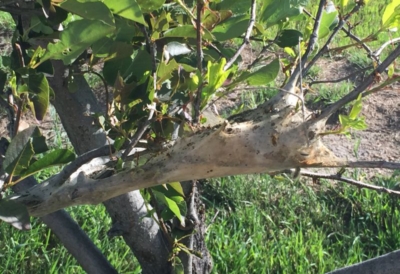Western Tent Caterpillar
Western Tent Caterpillar
The western tent caterpillar turns into moths. They will get into shrubs and trees to make their homes and cocoons, creating a silky white covering that affect the health of the plant life. The  creatures prevent nutrients getting into the tree, so they start to die out or become damaged. While any tree or shrub is at risk, the most common types of plants and trees chosen are oaks, fruit trees, cottonwood, and chokecherry.
creatures prevent nutrients getting into the tree, so they start to die out or become damaged. While any tree or shrub is at risk, the most common types of plants and trees chosen are oaks, fruit trees, cottonwood, and chokecherry.
The Lifecycle of the Western Tent Caterpillar
There is just one generation of the caterpillar every year. The first caterpillars will create a tent around the leaves and branches of the trees and shrubs, with this tent getting larger as the larve grow and feed. This tent becomes the protection and shelter for them to grow.
After 30 to 42 days, the larvae will mature and create their silky cocoons on the plant branches. As adults, the females will lay their eggs within the tree branches, damaging the interior of the branches and making it harder for the limited nutrients to spread.
Transformed caterpillars are moths of gray, tan, yellow, or red-brown colour. Their wings will usually have a pair of lines that stand out.
Knowing You Have a Western Tent Caterpillar Infestation
It’s usually very clear that you have a problem with these caterpillars due to the creation of the tent. The tent is white and silky, getting larger as the larvae continue to feed and grow.
You can also tell from the loss of leaves on the trees. The branches become thinner, so the leaves don’t get the nutrients they need. Many of the caterpillars will nest towards the top of the trees, so you may notice some of the falling leaves or lack of growth first, depending on the height of the tree.
If you have chokecherries, you may find that you have an infestation of numerous creatures and pests. The chokecherry offers a range of nutrients for insects.


Comments are closed.